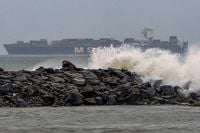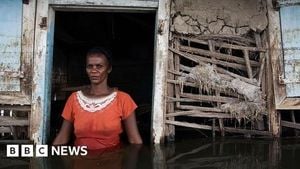As Cyclone Montha barreled toward India’s eastern coast, millions of residents in Andhra Pradesh and neighboring states braced for impact on Tuesday, October 28, 2025. The India Meteorological Department (IMD) had been tracking the storm’s steady intensification over the Bay of Bengal, warning of severe winds, torrential rain, and the potential for widespread disruption. By late evening, Montha—whose name, suggested by Thailand, means "fragrant flower"—had evolved from a deep depression into a severe cyclonic storm, setting its sights on the coastline between Machilipatnam and Kakinada.
Officials sounded red alerts across 19 districts in Andhra Pradesh, with orange and yellow alerts stretching into Rayalaseema, Tamil Nadu, and southern Odisha. The IMD forecast sustained winds of 90–100 km/h, with gusts reaching up to 110 km/h, and warned of extremely heavy rainfall in isolated coastal areas. As of 2:30 pm on October 28, Montha was just 150 km south-southeast of Kakinada and closing in at a brisk 12–15 km/h. Residents along the projected landfall path—Machilipatnam to Kalingapatnam—were told to expect the storm’s full fury before midnight.
Preparation was frantic and thorough. Andhra Pradesh authorities set up 3,174 rehabilitation centers, staffed by nearly 3,800 secretaries, and shifted almost 76,000 people from vulnerable areas to safety. In the words of Dr. G Lakshmisha, Collector of NTR district, "Everywhere, up to village-level response teams are kept on high alert. Today is the second day of Cyclone Montha. We are expecting the highest rainfall in Vijayawada city. So, to drain out the rainfall water, all the canals are kept vacant, and everyone is alert. All the departments, mainly the police, revenue, irrigation department, R&B department and electricity departments, are working in unison. The public is alerted well in advance, and they are all being shifted to the rehabilitation centres." (ANI)
The government’s response included more than just shelters. Over 219 medical camps were established, 865 tonnes of animal fodder stockpiled, and 1,447 earthmovers, 321 drones, and 1,040 chainsaws readied to clear uprooted trees and debris. Emergency communications relied on 81 wireless towers, 21 large lamps, and a flood of more than 3.6 crore alert messages sent to residents. Real-time voice alerts, SMS, IVR calls, and even traditional drum announcements kept the public informed, even in the event of power outages.
Transport came to a near standstill. South Central Railway cancelled 122 trains, with a total of 160 services affected as the cyclone’s approach threatened the Visakhapatnam and Vijayawada corridors. More than 35 flights between Shamshabad in Telangana and airports in Andhra Pradesh were cancelled, including services run by IndiGo, Air India, and Air India Express. The Andhra Pradesh State Disaster Management Authority barred heavy vehicles from national highways in the coastal districts from 7 pm Tuesday, urging the public to avoid travel unless absolutely necessary.
On the ground, the impact was immediate and severe. High tidal waves and a storm surge of about one metre above the astronomical tide inundated low-lying areas. The Uppada-Kakinada beach road was destroyed and closed to traffic. Great danger signals—the highest warnings for ports—were hoisted at Kakinada (signal 10), Visakhapatnam, Gangavaram, Kalingapatnam, and Bheemunipatnam (signal 9), and Machilipatnam, Nizampatnam, Krishnapatnam, and Vadarevu (signal 8), according to NDTV. Wind speeds at landfall reached 68 km/h in Machilipatnam and 52 km/h in Kakinada, with gusts elsewhere as the storm lashed the coast.
Not all consequences were material. In Makanagudem village, Konaseema district, a woman lost her life when an uprooted palmyra tree fell on her during the gales, a stark reminder of the storm’s deadly potential. The cyclone also devastated agriculture in Andhra Pradesh, destroying standing crops in 38,000 hectares and horticulture crops in another 1.38 lakh hectares, according to a press release from the chief minister’s office. "Due to the impact of the cyclone, heavy rains across the state destroyed standing crops in 38,000 hectares and horticulture crops in 1.38 lakh hectares," the statement read.
The IMD’s Director General, Dr. Mrutyunjay Mohapatra, emphasized the seriousness of the situation in an interview with NDTV: "Andhra Pradesh will be the most affected, followed by Odisha and then Chhattisgarh. Heavy rainfall will continue in Andhra Pradesh, Odisha, Chhattisgarh, and Tamil Nadu between October 28 and 30." As Montha crossed the coast, its effects rippled outward—flooding in Chennai led to a one-day closure of all schools, while the Greater Chennai Corporation set up 215 relief centers and 106 central kitchens to support residents in flood-prone areas. In Odisha, normal life was upended in 15 districts, with Chilika Lake turning turbulent and heavy rain inundating Rayagada and other southern districts.
Railways and airlines scrambled to minimize disruption. Union Minister Ashwini Vaishnaw reviewed cyclone preparedness, activating divisional war rooms and mobilizing resources across the East Coast, South Coast, and South Central Railway zones. The focus was on passenger safety, rapid restoration, and close coordination with disaster management agencies.
Political leaders also took center stage. Prime Minister Narendra Modi spoke with Andhra Pradesh Chief Minister N Chandrababu Naidu, promising federal assistance. Naidu, for his part, reviewed the situation from the Real Time Governance Society Centre, stating, "I have instructed officials to take preemptive protective measures to prevent loss of life and property due to the cyclone after reviewing the situation. We are continuously providing accurate information to the public to keep them alert." (X, formerly Twitter)
Evacuations were ongoing in more than 1,200 vulnerable villages, with 1,906 relief camps readied and special attention given to over 3,400 pregnant and lactating mothers. Eleven National Disaster Response Force (NDRF) and twelve State Disaster Response Force (SDRF) teams were deployed, alongside hundreds of medical and rapid response teams. Power and water supply teams, equipped with thousands of poles, transformers, tankers, and generators, stood ready for rapid restoration.
Even as Montha’s eye crossed the coast, its influence extended far beyond Andhra Pradesh. Heavy rain battered parts of Rajasthan, including Bundi, Udaipur, and Kota, while West Bengal’s Purulia district witnessed turbulent weather hours ahead of landfall. The cyclone’s broad reach underscored the interconnectedness of weather systems across India’s vast geography.
For millions, Cyclone Montha was a test of resilience and preparedness. The coordinated efforts of government agencies, meteorologists, first responders, and ordinary citizens—along with timely alerts and decisive action—helped limit casualties and property loss, even as the storm left a trail of destruction in its wake. As the skies begin to clear, the long process of recovery and rebuilding will commence, but the lessons of Montha will linger long after the winds subside.





